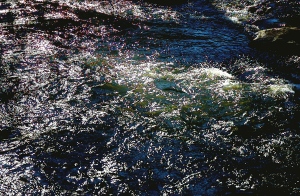
Reflecting and Refracting light
Reflections and Refractions: My first thoughts
What does it mean to reflect? What does it mean to refract? I took this picture at Eno River State Park on January 1,2009. Often a day of reflection and projection for many people. But the picture attempts to capture both reflections and also refractions; an idea I hope to explore in this blog.
The terms mean different things, depending on the individual context in which the term is used. A good starting point is to think about the terms from the perspective of physical science. In the physical world, specifically when talking about light, the terms describe the behavior of light traveling through different media. But in other domains, especially those that consider professionalism, there is an alternate use of reflection. In teacher education, reflection has become a practice and an artifact that intends to develop reflective practitioners.
Reflection and Refraction – A brief physical science lesson.
With reflected light, we commonly think about mirrors which create virtual images of objects – most often our faces. A simple explanation is that reflects all that light and absorbs none (the absorbed light results in the colors that we see). In refraction, the light is bent when traveling through a medium. The common experience with this is a rainbow. Light traveling through droplets of water is refracted. The colors of white light (red, orange, yellow, green, blue, and violet) travel at different speeds and are bent differently when refracted.
For more thorough explanations, see: http://en.wikipedia.org/wiki/Reflection_(physics) and http://en.wikipedia.org/wiki/Refraction.
Reflective Practice
I juxtapose the physical science ideas with the social science notion of reflective practice to consider what about the concept, actions, and products of reflective practice afford in terms of learning to teach. The concept arises from Schön’s ideas described in , Educating the Reflective Practitioner. I will not review all of Schön’s ideas, I assume most readers are familiar with the concept. I would like to consider some points. Schön talks about being able to “reflect on action” and “reflect in action”. “Reflection on action” refers to thinking about actions and events after the fact. While “reflection on action” is important, it should not be our final goal in preparing reflective practitioners. “Reflection in action” Schön implicitly argues is a distinguishing feature of professionals. It involves the ability to “reflect in action” and as a result reshape the outcomes of ongoing activities. What is done and how to novices learn to engage in “reflection on action”? The common response in teacher education is to have preservice teacher write ‘reflections’. Such written reflections are ultimately “reflections on action” and as products often fall short in my mind .
Using Reflection and Refraction to inform Reflective Practice
To explore this a bit further, let me think about the analogy between physical science and social science perspectives. Written reflections often attempt to produce mirror images of what happened in a situation. This has two problems. First, reflection of this sort fails to explore what happened in the context or situation that resulted in the image described. From the perspective of behavior of light, the reflection (the image of my face) is as much a result of reflected light as it is of the light absorbed by my face. In the context of describing the teaching experiences in a reflection, preservice teachers need to consider what is absorbed in the context and as a result, not included in the images that they portray in their reflections. From the analogy of mirrors and light, reflections are as much a product of the events that transpired and the factors that led to those events as the final outcome or description of the event. Second, focusing on the notion of refraction, the majesty and beauty of a rainbow is a result of bent light. Light interacts with water particles in the air and is affected by the water. I would argue that in teaching, similar events occur. Examinations of teaching should consider the event of refraction to reveal the shades, colors, and hues of the context, actions, and participants. These products are absent in the written reflection because the format and form of reflection creates linear re-presentations (like this post) of ideas and thoughts. An additional problem with reflections relates to Schön’s construct, “reflection in action” . It is difficult to record and represent this kind of reflection in a written reflection. Written reflections reflect static instances, after the fact, failing to reveal a decision in action. If we agree that this later kind of reflection is a hallmark of professionalism, it seems that teacher educators should learn more about about to develop and scaffold prospective teachers’ “reflection on action”.
note to the reader:
I can’t claim that this thinking is a result of my own insightful provocation. I was most moved by Lynn Fendler’s Educational Researcher article on Reflection. I highly recommend it and will list the full citation on the resources.